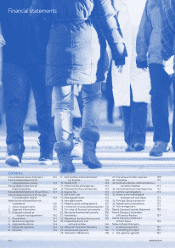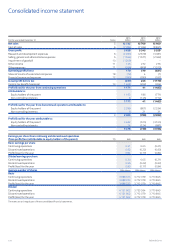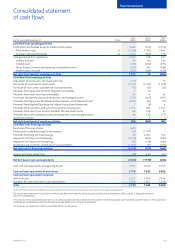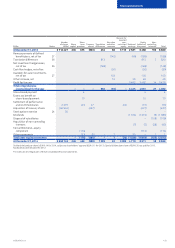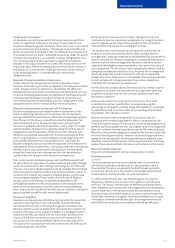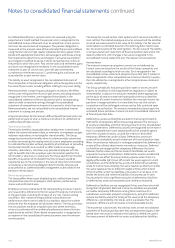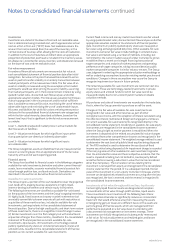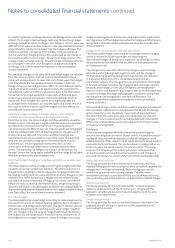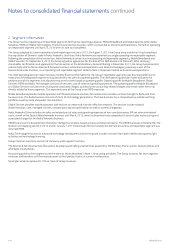Nokia 2014 Annual Report Download - page 132
Download and view the complete annual report
Please find page 132 of the 2014 Nokia annual report below. You can navigate through the pages in the report by either clicking on the pages listed below, or by using the keyword search tool below to find specific information within the annual report.130 NOKIA IN 2014
1. Accounting principles
Corporate information
Nokia Oyj, a public limited liability company incorporated and domiciled
in Helsinki, Finland, is the parent company for all its subsidiaries
(“Nokia” or “the Group”). The Group’s operational headquarters are
located in Espoo, Finland. The Group is listed on the Nasdaq Helsinki
stock exchange and the New York stock exchange.
The Group is a leading global provider of network infrastructure and
related services, with a focus on mobile broadband, location and
mapping services as well as advanced technology development
and licensing.
On March 19, 2015 the Board of Directors authorized the nancial
statements for 2014 for issuance and ling.
Basis of presentation
The consolidated nancial statements of the Group are prepared in
accordance with International Financial Reporting Standards as issued
by the International Accounting Standards Board (“IASB”) and in
conformity with IFRS as adopted by the European Union (“IFRS”).
The consolidated nancial statements are presented in millions of
euros (“EURm”), except as otherwise noted, and are prepared under
the historical cost convention, except as disclosed in the accounting
policies below. The notes to the consolidated nancial statements
also conform to the Finnish accounting legislation.
In 2014, substantially all of the Devices & Services business was sold
to Microsoft. This is referred to as the “Sale of the D&S Business”.
Refer to Note 3, Disposals treated as discontinued operations.
In 2014, certain items in the consolidated income statement and the
consolidated statement of nancial position have been reclassied
to conform with current year presentation.
Other information
This paragraph is included in connection with statutory reporting
requirements in Germany. The fully consolidated German subsidiary,
Nokia Solutions and Networks GmbH & Co. KG, registered in the
commercial register of Munich under HRA 88537, has made use
of the exemption available under § 264b of the German Commercial
Code (“HGB”).
Adoption of pronouncements under IFRS
In the current year, the Group has adopted the following new and
revised standards, amendments and interpretations to existing
standards issued by the IASB that are relevant to its operations
and eective for accounting periods commencing on or after
January 1, 2014.
Amendment to IAS 32 Osetting Financial Assets and Financial
Liabilities claried the meaning of “currently has a legally enforceable
right to set-o”.
Recoverable Amount Disclosures for Non-Financial Assets
(Amendments to IAS 36) added guidance to IAS 36 Impairment of
Assets on disclosure of recoverable amounts and discount rates.
Novation of Derivatives and Continuation of Hedge Accounting
(Amendments to IAS 39) made it clear that IAS 39 Financial
Instruments: Recognition and Measurement does not require
discontinuing hedge accounting if a hedging derivative is novated,
provided certain criteria are met.
Dened Benet Plans: Employee Contributions (Amendments to
IAS 19) claried IAS 19 Employee Benets requirements that relate
to how contributions from employees or third parties that are linked
to service should be attributed to periods of service.
IFRIC 21 Levies, an interpretation of IAS 37 Provisions, Contingent
Liabilities and Contingent Assets,
claried that the obligating event
giving rise to a liability to pay a levy to a government agency is the
activity that triggers the payment.
In addition, a number of other amendments that form part of the
IASB’s annual improvement project were adopted by the Group. The
adoption of the above amendments and interpretations did not have
amaterial impact on the Group’s consolidated nancial statements.
Additional disclosures have been provided in the notes to the nancial
statements where applicable.
Signicant accounting principles
Principles of consolidation
The consolidated nancial statements comprise the nancial
statements of Nokia Oyj as the parent company (“Parent Company”),
and each of those companies over which the Group exercises control.
Control over an entity exists when the Group is exposed, or has rights,
to variable returns from its involvement with the entity and has the
ability to aect those returns through its power over the entity.
When the Group has less than a majority of voting or similar rights
of an entity, the Group considers all relevant facts and circumstances
in assessing whether it has power over an entity, including the
contractual arrangements and the Group’s voting rights and potential
voting rights. The Group reassesses whether or not it controls an
entity if facts and circumstances indicate that there are changes
to one or more of the three elements of control.
All inter-company transactions are eliminated as part of the
consolidation process. Non-controlling interests are presented
separately as a component of net prot and are shown as a
component of shareholders’ equity in the consolidated statement
of nancial position.
Acquired entities or businesses have been consolidated from the date
on which control over the net assets and operations was transferred
to the Group. Similarly, the results of Group entities or businesses
disposed of are included in the consolidated nancial statements
only up to the date of disposal.
Business combinations
The acquisition method of accounting is used to account for
acquisitions of separate entities or businesses. The consideration
transferred in a business combination is measured as the aggregate
of the fair values of the assets transferred, liabilities incurred towards
the former owners of the acquired entity or business and equity
instruments issued. Acquisition-related costs are recognized as
expenses in the consolidated income statement in the period in
which the costs are incurred and the related services are received.
Identiable assets acquired and liabilities assumed are measured
separately at the acquisition date fair values.
Non-controlling interests in the acquired business are measured
separately at fair value or at the non-controlling interests’
proportionate share of the identiable net assets of the acquired
business. The excess of the cost of the aggregate consideration
transferred over the acquisition date fair values of the identiable
net assets acquired is recorded as goodwill.
Notes to consolidated nancial statements




